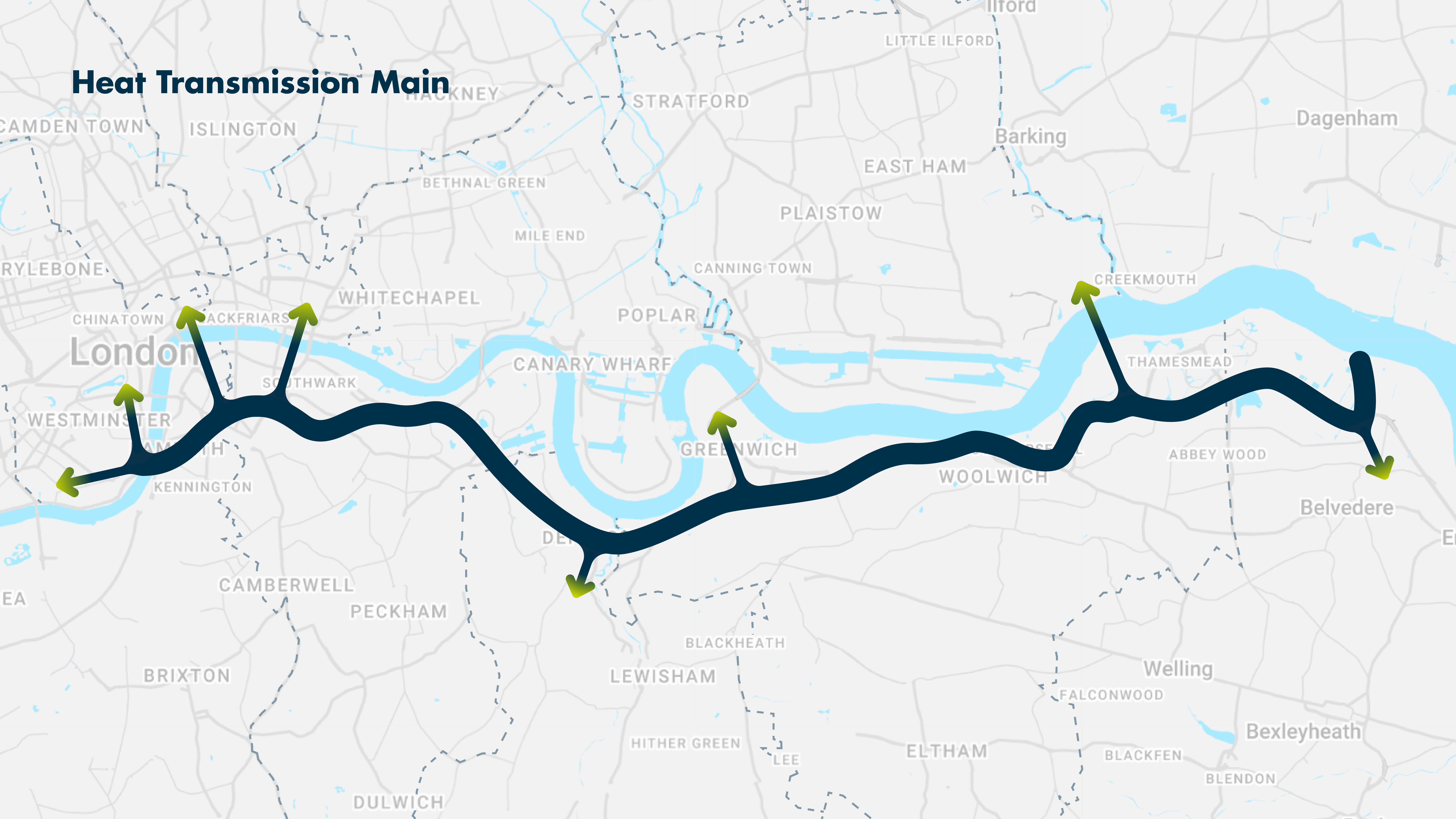 Friday, 26th September, 2025
Friday, 26th September, 2025
Cory announces plans for UK’s first large-scale heat transmission system
- Project will support multi-billion pound investment in local heat networks
- Supports wider work to decarbonise heating in London and will bring heat to c.300,000 homes and businesses
- First-of-a-kind project in the UK would create a template for cities across the country
- Using waste heat from industrial processes can cut carbon emissions, boost energy security, and reduce electricity grid upgrade costs
- First time a heat infrastructure project has been designated as nationally significant by the Department of Energy Security and Net Zero
- Construction targeted to start in 2028, with heat supplied from 2032
A project to build a new heat transmission main for London has been designated as nationally significant by the Secretary of State for Energy Security and Net Zero. It will provide heat across multiple London boroughs, and will help to unlock c.£5bn which is forecast to be invested in heat networks under local area energy plans.
The heat main would be constructed using underground tunnelling, similar to the Elizabeth Line and Thames Tideway tunnel, and move hot water from Bexley on the Thames estuary into south-east and central London – enabling industrial waste heat to provide heating and cooling to homes and business.
The project is sponsored by Cory and will make use of industrial waste heat, initially drawn from Cory’s existing Riverside 1 energy from waste (EfW) plant, located in the London Borough of Bexley. The heat will be used to warm water, which will then be pumped through tunnels. That heat will then be transferred to distribution networks, which will supply it to individual buildings through a network of smaller hot water pipes. Future plans for the network include the opportunity for other heat sources to connect into it.
Using waste heat from industrial processes can supply affordable, low-carbon heat at scale to communities; using heat which already exists avoids additional energy generation and the need for extracting fossil fuels. Cory’s operations alone will produce enough waste heat to meet the entire demand of the City of London, plus approximately half of the City of Westminster every year, and it is estimated that this project will be able to supply heat to around 300,000 homes across south-east and central London. Using locally-sourced heat also provides energy security and protection from volatile prices associated with importing gas from outside the UK.
District heat projects have long been used in Europe to provide affordable heat to communities. In Copenhagen, over 98% of the city is supplied by district heating, with much of the heat for the network being supplied by large transmission mains. Large district heat infrastructure is currently rarer in the UK, but, supported by the Climate Change Committee, the UK Government has announced a target of delivering 20% of the UK’s heat demand through district heating by 2050. In large cities like London, where the opportunity is best, this may be closer to 40%.
Several large heat networks are already under development in London, such as the South Westminster Area Network (SWAN) and Old Oak and Park Royal Energy Network (OPEN). Other large networks are due to be tendered soon. Cory is working with a number of heat network developers who operate or are developing new networks in London, such as 1Energy, Bring Energy, E.ON, Hemiko, Vital Energi and Vattenfall.
This project is well aligned with the strategic energy infrastructure work undertaken by the Greater London Authority (GLA), including its sub-regional local area energy plans and the London waste heat study, which mapped out strategic waste heat sources and transmission corridors across Greater London. It is the first heat transmission main project to come forward since the study was presented by the GLA this summer.
David Carter, Managing Director – Heat at Cory Group, said: “Cory is working on several projects which bring together the public and private sectors across London to transform how we heat homes and businesses. This is our most ambitious. We have a proud track record of delivering challenging infrastructure projects, and an over 200-year history of innovating to serve London and the wider UK. This project will provide a template for decarbonisation not only in London, but across the country. It will promote jobs and drive investment in UK infrastructure at a time when economic growth is a national priority.”
Mete Coban, Deputy Mayor of London for Environment and Energy, said: “Heat networks have an important role to play in helping London achieve net zero carbon by 2030 and it’s great to see Cory leading on this to support the green energy transition. By capturing waste heat from industrial centres and using it to heat our homes and businesses, we can cut emissions, supply low carbon heat at a fair cost to consumers and make London more resilient. This ambitious project is exactly the type of innovation we need as we continue building a better and greener London for everyone.”
Andrew Wettern, CEO at 1Energy, said: "Cory’s Strategic Heat Main Development represents a step change for London: for the first time, heat networks across borough boundaries will be able to tap into a reliable source of low-carbon waste heat at scale. This project has the potential to unite local networks into a city-wide system, unlocking carbon savings and improving energy security. For 1Energy, this provides a huge boost to projects we've been working on in London, supporting our goal of helping local businesses and public sector organisations move away from fossil fuels and deliver low carbon heat across the city. "
Mark Raymond, Concession Management Director, Bring Energy, said: "Heat networks are a vital part of the UK’s journey to net zero, offering a proven way to decarbonise how we heat our homes and workplaces. Projects like this show how waste heat can be captured and transmitted at scale, turning what would otherwise be lost into affordable, low-carbon energy for communities. At Bring Energy, we are focused on building and operating networks that can connect into this kind of strategic infrastructure – making better use of existing energy, strengthening security of supply, and keeping costs more stable for households and businesses. This is exactly the type of model that can be replicated across UK cities to unlock the full potential of waste heat and heat networks."
Vijay Tank, Chief Commercial Officer at E.ON Energy Infrastructure Solutions UK, said: “London already wastes enough heat to meet almost 40% of its heating demand and at E.ON we are exploring ways to capture and recycle excess heat, whether from data centres, fridges, sewers or industrial sites, all of which can be used as a more sustainable way to warm homes, shops and schools. Our existing 11km network of heating and cooling pipes in the Square Mile calls on deep geothermal boreholes 200m underground for a source of sustainable heat. Cory’s plans for a ‘heat transmission main’ is a critical step forward for the Mayor’s push to deliver affordable decarbonised heat; capturing energy where it’s generated, and transporting for use where needed in the heart of the city.”
Charlotte Owen, Director at South Westminster Area Network Partnership, said: “Heat transmission mains are an important enabler of city-scale decarbonisation. Whilst they are well-established in other parts of the world, the UK has none. This is why we are pleased to see the development of the first reach this important milestone.
To enable the growth of networks like the South Westminster Area Network (SWAN) to supply more and more buildings, we need to unlock as many heat sources as possible. This new heat main will deliver affordable heat from the outskirts of the city to its centre, where it can be used to sustainably and efficiently heat homes and buildings."
Alina Gheorghiu-Currie, Vattenfall’s Director of Heat Networks – London, said: "Capturing waste heat to supply homes, businesses, and public sector buildings is critical to the deployment of heat networks across the UK. Vattenfall is already working with Cory on the Riverside Heat Network to develop a low carbon heat network that will reduce emissions and provide communities in Thamesmead and Abbey Wood with reliable heating and hot water. The strategic heat main complements these plans, building vital infrastructure that allows even more Londoners to benefit and accelerates the capital towards a low carbon future."
The ‘Nationally Significant’ infrastructure designation highlights the importance of the project, and means it may participate in the process used to determine whether to authorise major infrastructure projects. This is the first time heat network infrastructure has been given this designation.
ENDS
